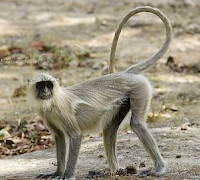

At the moment the design is too small and will need to be scaled up. I was originally going to make the female 18" in height, and the male 21" in height, which are the average heights respectively for rhesus macaques. However, I have been thinking that it would be as well to make each a few inches taller, since monkeys rarely stand at their full height, and for the purposes of sight lines in the theatre it will be as well to err on the taller side. The only limitation is the weight of a marionette, which increases with size, but I think that 20" for the female and 23" for the male will be fine. The late John Wright recommended not exceeding 24" for an all-wood marionette in his book Your Puppetry.
I will refine the contours further, but am quite happy at this stage with the view from the side.
The next challenge of course will be to work on the design from the front.
The other thing I have been pondering today is the neck joint, whether it should be in the head or in the body, plus whether to have joints in the feet and a waist joint. Hmmm. I have been playing with clay and plaster.






















